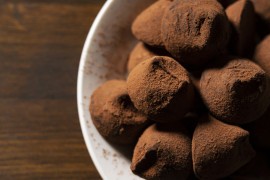Candy canes: the sweet star of American Christmas
It's impossible to imagine Christmas in the United States without these red and white canes hanging from Christmas trees or tucked into stockings. Their peppermint flavor and stripes symbolize celebration, generosity, and childhood. The exact origin of the candy cane remains unclear. The first sugar sticks already existed in Europe in the 17th century. But it was in the 19th century, in the United States, that the curved shape and mint flavor appeared. A German-Swedish immigrant, August Imgard, is said to have decorated his Christmas tree with sugar sticks as early as 1847 in Ohio. A few decades later, American confectioners perfected the manufacturing process: the canes became striped, flavored, and industrially produced, making them a Christmas icon.
European roots and a little-known French origin
Before the American candy cane, Europe was already making clear sugar sticks called barley sugar. And it was in France, in Moret-sur-Loing (Seine-et-Marne), that this specialty was born.
A Benedictine nun in traditional dress in a French convent, symbolizing France's history and religious heritage. Par éditeur : éd. Bray et Retaux (Paris) — Gallica [1], Domaine public, https://commons.wikimedia.org/w/index.php?curid=41481251
In 1638, Benedictine nuns from the Notre-Dame-des-Anges convent developed a confectionery made from cooked sugar and hulled barley extract. The result was a translucent, golden, hard, and smooth candy that soothed the throat. It was first distributed as a remedy before becoming a sought-after treat. This Moret barley sugar is now considered the oldest candy in France. Its recipe has been preserved and it is still produced using traditional methods, without artificial colors or flavors.
👉 Discover the Maison du Sucre d'Orge in Moret-sur-Loing
The link between candy canes and barley sugar
Although the candy cane did not originate in Moret-sur-Loing, it inherited the idea: that of a stick of cooked sugar that is hardened by pulling it. America added the color, mint, and cane shape, but the principle is the same. You could say that candy canes are the festive, colorful version of French barley sugar. One evokes fresh mint and snow, the other caramel and Christmas markets of yesteryear. Two continents, one same gesture: cooking sugar to make a sweet treat.
American candy cane recipe
Good barley sugar. Photo selected by monsieurdefrance.com: Depositphotos
Want to make your own Christmas canes? Here is a simple recipe inspired by American confectioners.
Ingredients:
- 500 g sugar
- 100 g corn syrup (or glucose)
- 60 ml water
- A few drops of peppermint essential oil
- Red food coloring
- A little neutral oil to grease the work surface
Preparation:
- Heat the sugar, syrup, and water over medium heat to 150-155°C (soft ball stage).
- Remove from the heat and add the peppermint.
- Pour onto a marble slab or oiled baking sheet.
- Allow to cool slightly until the mixture is malleable.
- Divide it in two: one part remains white, the other becomes red.
- Form two ropes, twist them together, then bend one end to create the cane shape.
- Leave to harden at room temperature.
The result: homemade candy canes with an authentic taste, crispy and shiny.
French barley sugar recipe
To taste the original sweetness, here is the recipe for Moret barley sugar, as it is still made in the historic shop.
par Coco Zinva de Pixabay
Ingredients:
- 500 g sugar
- 150 ml water
- 2 tablespoons hulled barley extract (or malt syrup)
- A few drops of lemon juice
Preparation:
- Pour the sugar and water into a saucepan. Heat gently until completely dissolved.
- Then heat to 155°C without stirring.
- Remove from the heat, add the barley extract and mix gently.
- Pour the mixture onto an oiled marble slab and leave to cool.
- Pour into molds or quickly shape into sticks before it hardens.
- Leave to cool completely before storing in an airtight container.
This barley sugar contains no added colorings or flavorings: it is pure caramelized sugar, slightly golden, just like in the old days.
Candy canes and barley sugar: two sweets, one story
The comparison between the two candies is fascinating. American candy canes and French barley sugar share the same manufacturing principle: cook sugar until it becomes translucent and hard, then shape it into a long stick. But their appearance and taste differ. Candy canes are red and white, curved into a cane shape and flavored with peppermint, while French sugar cane remains golden, smooth, and caramelized, with no added flavor. One symbolizes American freshness and celebrations; the other, artisanal purity and French tradition.
The differences don't end there:
- The candy cane was born in the 19th century, in an already industrialized America.
- Barley sugar, on the other hand, dates back to the 17th century, a time of convents and manual labor.
In short, the candy cane is the festive and colorful descendant of French barley sugar, a European heritage transformed by the New World.
Christmas in France
In France, Christmas is a true celebration of the senses: lights, traditions, and delicacies come together to create a unique atmosphere. On this site, you can discover the most beautiful illuminated cities, French Christmas traditions, and iconic recipes to make at home: Alsatian Christmas cakes, mulled wine, chocolate truffles, and Christmas Log.
Each page immerses you in the magic of French Christmas, from regional traditions to homemade treats.
👉 Discover Christmas in France
FAQ: candy canes and barley sugar
What is the origin of the candy cane?
It dates back to 17th-century European sugar sticks, but its current form (red, white, mint-flavored) originated in the United States around 1850.
Is French barley sugar older?
Yes! It was invented in 1638 by nuns in Moret-sur-Loing, near Paris. It is the oldest candy in France.
What is the difference between candy canes and barley sugar?
Candy canes are colorful and flavored with mint. Barley sugar is golden, with no added flavor, and has a more natural, caramelized taste.
Can you make barley sugar at home?
Yes! All you need is sugar, water, and a little barley or malt syrup, cooked to 155°C.
Do candy canes really come from barley sugar?
Indirectly, yes: the technique and principle come from Europe, particularly France. Americans have transformed it into a decorative and flavored version.
Where can you buy real barley sugar?
In Moret-sur-Loing, where the Maison du Sucre d'Orge continues to make the original recipe by hand.
How long do these candies keep?
Several months, in an airtight container, away from moisture.
What to drink with them?
Coffee, mulled wine, or hot chocolate! Barley sugar melts slowly and adds a caramelized note.
<time datetime="2025-11-10">Mise à jour : novembre 2025</time>











